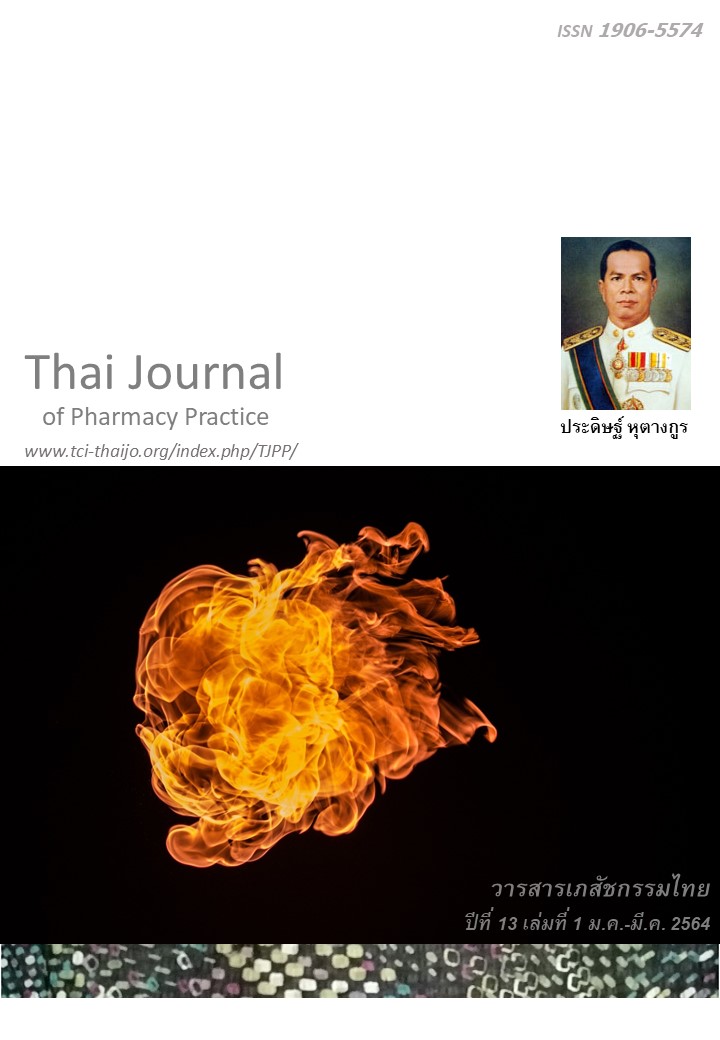ผลของการให้บริบาลเภสัชกรรมต่อปัญหาจากการใช้ยาในผู้ป่วยสูงอายุโรคเบาหวานชนิดที่ 2
Main Article Content
บทคัดย่อ
วัตถุประสงค์: เพื่อประเมินผลของการให้บริบาลเภสัชกรรมต่อปัญหาจากการใช้ยา (drug related problems: DRPs) ในผู้ป่วยสูงอายุโรคเบาหวานชนิดที่ 2 วิธีการ: การวิจัยนี้เป็นการศึกษาเชิงทดลองในผู้ป่วยสูงอายุโรคเบาหวานชนิดที่ 2 ที่เข้ารับการรักษาตัวในโรงพยาบาลจำนวน 180 คน โดยแบ่งกลุ่มตัวอย่างออกเป็นกลุ่มศึกษาและกลุ่มควบคุม กลุ่มละ 90 รายด้วยวิธีสุ่มแบบ block randomization กลุ่มศึกษาได้รับการบริบาลทางเภสัชกรรมเพิ่มร่วมกับการบริการตามมาตรฐานของโรงพยาบาล กลุ่มควบคุมได้รับการบริการตามมาตรฐานของโรงพยาบาล ผู้วิจัยติดตามผู้ป่วยทั้งสองกลุ่มตั้งแต่วันแรกรับ ณ หอผู้ป่วยในจนสิ้นสุดการศึกษาที่เวลาติดตาม 3 เดือน ณ แผนกผู้ป่วยนอก ผลลัพธ์ของการศึกษาได้แก่ สัดส่วนของผู้ป่วยที่พบ DRPs, จำนวน DRPs ประเภทของ DRPs และความร่วมมือในการใช้ยาของผู้ป่วย ผลการวิจัย: เมื่อสิ้นสุดการศึกษามีจำนวนผู้ป่วยทั้งสิ้นคงเหลือ 164 คน (กลุ่มศึกษา 83 คนและกลุ่มควบคุม 81 คน) กลุ่มศึกษามีสัดส่วนผู้ป่วยที่พบ DRPs ร้อยละ 86.7 โดยพบแนวโน้มลดลงมากกว่าเมื่อเทียบกับกลุ่มควบคุม (ร้อยละ 95.1) แต่ไม่พบนัยสำคัญทางสถิติ (P=0.056) จำนวน DRPs ต่อคนเฉลี่ยในกลุ่มศึกษาลดลงเหลือ 1.4±0.8 ซึ่งแตกต่างกับกลุ่มควบคุม 2.2±0.9 (P<0.001) โดยชนิดของ DRPs ที่พบลดลงอย่างชัดเจน ได้แก่ ความไม่ร่วมมือในการใช้ยา การใช้ยาโดยไม่จำเป็น และการใช้ยาไม่สมเหตุผล ผู้ป่วยในกลุ่มศึกษามีสัดส่วนของผู้ให้ความร่วมมือในการใช้ยา (ร้อยละ 26.5) สูงกว่ากลุ่มความคุม (ร้อยละ 13.6) (P=0.039) และมีคะแนนพฤติกรรมการใช้ยาเฉลี่ย (22.0±1.9 คะแนน) มีแนวโน้มที่ดีขึ้นแตกต่างจากกลุ่มควบคุม (20.4±3.0 คะแนน) (P=0.016) สรุป: การให้บริบาลทางเภสัชกรรมในผู้ป่วยสูงอายุโรคเบาหวานชนิด 2 มีแนวโน้มลด DRPs รวมทั้งมีแนวโน้มการเพิ่มจำนวนผู้ป่วยที่ให้ความร่วมมือในการใช้ยา
Article Details
ผลการวิจัยและความคิดเห็นที่ปรากฏในบทความถือเป็นความคิดเห็นและอยู่ในความรับผิดชอบของผู้นิพนธ์ มิใช่ความเห็นหรือความรับผิดชอบของกองบรรณาธิการ หรือคณะเภสัชศาสตร์ มหาวิทยาลัยสงขลานครินทร์ ทั้งนี้ไม่รวมความผิดพลาดอันเกิดจากการพิมพ์ บทความที่ได้รับการเผยแพร่โดยวารสารเภสัชกรรมไทยถือเป็นสิทธิ์ของวารสารฯ
References
Duangthipsirikul S, Sirisamut T, Tantipisitkul K, Tirawattananon Y, Ingsrisawang L. Preliminary study report: Health surveys of Thai older adults 2013 [online]. 2014 [cited Aug 4, 2019]. Available from: www.hitap.net/documents/24067.
National Statistical Office. Report on the 2017 survey of the older person in Thailand [online]. 2017 [cited Aug 4, 2019]. Available from: www. nso.go.th/sites/2014.
Morin L, Johnell K, Laroche M-L, Fastbom J, Wastesson JW. The epidemiology of polyphar- macy in older adults: register-based prospective cohort study. Clin Epidemiol. 2018; 10: 289-98.
Cantlay A, Glyn T, Barton N. Polypharmacy in the elderly. InnovAiT 2016; 9: 69-77.
Nachtigall A, Heppner HJ, Thürmann PA. Influence of pharmacist intervention on drug safety of geriatric inpatients: a prospective, controlled trial. Ther Adv Drug Saf. 2019; 10: 1-15.
van Roozendaal BW, Krass I. Development of an evidence-based checklist for the detection of drug related problems in type 2 diabetes. Pharmacy World Sci. 2009; 31:580-95.
Korcegez EI, Sancar M, Demirkan K. Effect of a pharmacist-led program on improving outcomes in patients with type 2 diabetes mellitus from Northern Cyprus: A randomized controlled trial. J Manag Care Spec Pharm. 2017; 23: 573-82
Uyprasert P. Impact of patient counseling in diabetic patients at Pathumthani hospital [master thesis]. Nakorn Pathom: Silpakorn University; 2004.
Noordzij M, Tripepi G, Deckker FW, Zoccali C, Tanck MW, and Jager KJ. Sample size calculations: basic principles and common pitfalls. Nephrol Dial Trans plant. 2010; 25: 1388-95.
Kongsomboon K. Epidemiological research for medical student. Bangkok: Chulapress; 2014
Cipolle RJ, Strand LM, Morley PC. Chapter 5. drug therapy problems. In: Cipolle RJ, Strand LM, Morley PC, editors. Pharmaceutical care practice: The patient-centered approach to medication management services, New York, NY: McGraw-Hill; 2012.
American Geriatrics Society 2019, Beers Criteria Update Expert Panel. American Geriatrics Society 2019 updated Beers Criteria for potentially inappropriate medication use in older adults. J Am Geriatr Soc 2019; 67: 674–94.
Sonsa-ardjit N. Psychometric properties of the patient-reported outcome measure of pharmaceutical therapy: quality of life (PROMPY-QOL) at King Chulalongkorn memorial hospital. [master thesis] Bangkok: Chulalongkorn University; 2014.
Davis LL. Instrument review: Getting the most from a panel of experts. Appl Nurs Res.1992; 5: 194-7.
Lexi-Comp Inc. Drug information handbook with international trade names index. 27th ed. Hudson, Ohio: Lexi-Comp; 2018-2019
Tatro DS. Drug interaction facts 2015: The authority on drug interactions 2015. Saint Louis, Missouri: Wolters Kluwer Health; 2015.
Naranjo CA, Busto U, Sellers EM, Sandor P, Ruiz I, Roberts EA, Janecek E, et al. A method for estima ting the probability of adverse drug reactions. Clin Pharmacol Ther 1981; 30: 23945.
Priprem S. Pharmacognosy of Vernonia amygdalina [online]. 2018 [cited Aug 4, 2019]. Available from: ccpe.pharmacycouncil.org/index.php?option=article_detail&subpage=article_detail&id= 544
Koh Y, Kutty FBM, Li SC. Drug-related problems in hospitalized patients on polypharmacy: the influence of age and gender. Ther Clin Risk Manag 2005; 1: 39-48.
Lekphet J. Medication therapy management for type 2 diabetic out patients by the pharmacist at Nongbua Hospital [master thesis]. Bangkok: Chula longkorn University; 2011.
Mongkolchaipak T. Factors affecting medication adherence of diabetic patients at Police general hospital. [master thesis]. Bangkok: Chulalongkorn University; 2014.
Bua-Khwan W, Pichayapaiboon S. Potentially inappropriate medication usage by nursing home residents. Thai Journal of Pharmacy Practice 2016; 8: 3-14.

